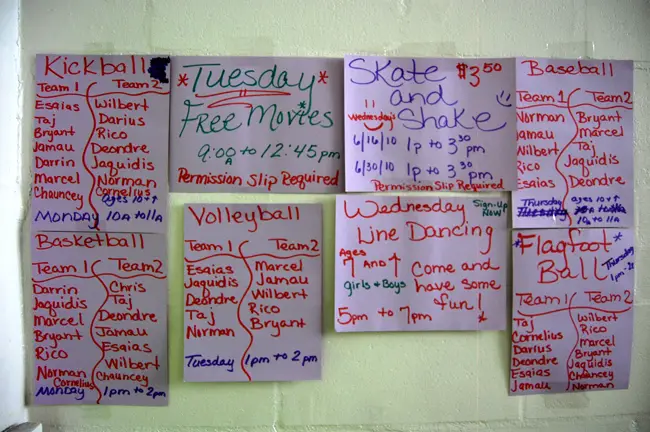
The Flagler County Commission doesn’t need the school board’s permission to close Carver Gym, the old recreation and community center in Bunnell’s almost exclusively black and chronically run-down part of town. The commission leased the gym from the school board in August 1982 in exchange for the commission’s pledge to renovate the last remaining building of what once was George Washington Carver High School, and to use it to the neighborhood’s benefit.
In mid-June a majority of county commissioners said they want to close the gym to save $110,000, pending other local governments such as Bunnell and the school district’s willingness to step in and bail out the gym.
Click On:
- How Race and Deception Are Cleaving the Fate of Bunnell’s Carver Gym
- Palm Coast Roller Derby Set Sights on Carver Gym
- A Confused but Adamant Bunnell Commission Wants Carver Gym to Stay Open
Outgoing Superintendent Bill Delbrugge and the school board are under the impression that should the county close the gym, the property might revert back to the school board. But the school board doesn’t own the property anymore. On Sept. 6, 2005, the board signed over a warranty deed granting the county ownership of the building “forever.” The deed bears the signature of Bill Delbrugge and Sue Dickinson, who chaired the board at the time and still serves today.
While the county commission may not need the board’s permission or worry that the building would revert to the school district if it goes unused, closing the gym is becoming increasingly unlikely.
The school board doesn’t want it closed. The Bunnell City Commission doesn’t want it closed. The community around Carver Gym doesn’t want to see it closed. Not even County Commission Chairman Gorge Hanns wants it closed. He’s already said that he’d vote to keep it open if it came to that.
“That absolutely cannot happen,” School Board Chairwoman Evie Shellenberger in a board meeting Wednesday evening, summing up the board’s position on the gym. The board was discussing the gym’s fate in response to a letter from the county commission, sent to the district and to Bunnell, seeking input on whether either was interested in contributing money to keep it open. The board’s voice was the latest in a chorus of opposition against closing the gym.
So it’s come down to four commissioners against everyone else. The trick isn’t merely to find a solution for Carver Gym, but to give the commission a way to save face. There was an attempt to do that, too, Wednesday evening.

Among the solutions the board is proposing is a committee made up of all concerned—Bunnell, the school district, the county commission and others—to hash out possibilities. One of those possibilities entails the school district taking back the building and the property it sits on, which are valued at $350,000, and running either adult community education programs there or contracting with the Boys and Girls Club, which is already there, to be the exclusive director of programming at the gym. The Boys and Girls Club is wanting to leave Carver because it has little control over matters there.
Both superintendents (Delbrugge and his replacement, Janet Valentine), in what amounted to one of their last acts as co-superintendents, made clear that the gym doesn’t have to—and should not be allowed to—close.
“It’s almost an institution in that neighborhood, and I really feel like we need to help carry along the programs that are there and keep that alive,” Valentine said. “I know we can’t afford to do that on our own. I think it’s possible for us to contribute in different ways.”

But board member Colleen Conklin doesn’t want to give the county a pass on its own responsibility . “I’m disheartened by the discussion that the county has had in regards to Carver Gym, ” she said. “When I read about it, I was definitely taken aback. I think it is a partnership and I think it is a responsibility of the county to provide those services.” The county, she said, should not get the impression “that they are financially off the hook. Our budget is just as tight as theirs is.”
It’s about far more than budgets, however, considering what Carver Gym represents for the community around it, and how closing it would reopen old wounds in a neighborhood long used to being treated as second class by the white power structure around it.
Earlier in the discussion, Delbrugge noted how “the property was given to the county to do this, just like the property beside that was given to HUD to build homes,” HUD being the federal Housing and Urban Development agency, “and not a single home has gone up on that property. So it might be best for us to ask for our property back,” at which point he suggested the Boys and Girls Club option.
The HUD history is particularly instructive as a reminder of the bleak context of Carver Gym’s social geography.
In November 1979, HUD approved the former Carver High School property, with the exclusion of the gym, for a 40-unit housing development for low-income residents. The school board the following year sold 10 acres to HUD and used the money to build Buddy Taylor Middle School on land donated by ITT. The 40 units were never built around Carver Gym: the Bunnell City Commission blocked the project, claiming, in an infamous 4-0 vote, that there was no additional low-income housing need in the city, even though 80 families had applied and been wait-listed for the units in 1979, according to figures reported at the time by Martin McDaniel, who was the Flagler County Housing Authority executive director.
The authority tried again in 1983. That time commissioners complained that the project would strain the city’s water and sewer system, while then-Commissioner Cary Holland criticized federal payments to the city as a “pittance.”
It was all a ruse to prevent the project from being built. It may be ancient history, and the city’s white, and whitewashing, memory would like it to be, but it isn’t: the HUD scandal was one of many examples in Bunnell’s history, and south Bunnell’s history in particular, of how bigotry couched in bureaucratic boils stopped services from reaching those who needed them. Those who needed them, in South Bunnell, were black. The story’s color scheme hasn’t changed.




























Robert L says
Wow . Now this is what one calls journalism. I read this paper for the news, I scan the DNJ and the PC Observer for limp commentary. I don’t believe that anyone would or could write such truth in the other information sources masquerading as news papers.
“It was all a ruse to prevent the project from being built. It may be ancient history, and the city’s white, and whitewashing, memory would like it to be, but it isn’t: the HUD scandal was one of many examples in Bunnell’s history, and south Bunnell’s history in particular, of how bigotry couched in bureaucratic boils stopped services from reaching those who needed them. “
Jim Guines says
I am very proud of the school board’s response to this issue. Having served with them for over ten years, I would expect them to come forth with a responsible next step solution and a fiscally sound plan. That is why the school system has been able to go so long without laying off teachers and cutting programs. I would put this group of managers and policy makers up against any management group in the cities and county.